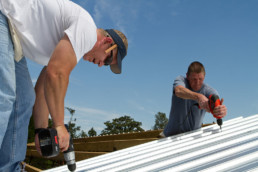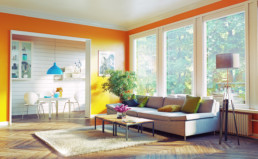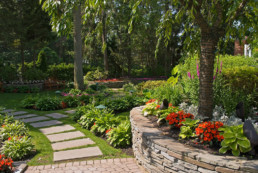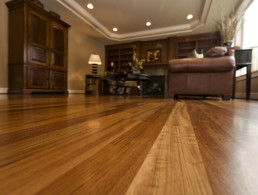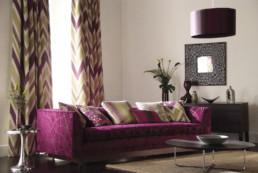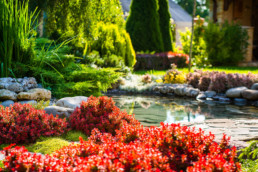Home Improvements: How New Windows Will Lower Your Heating and Cooling Bills
Now that you’ve made the decision to spend a little money on home improvement, it pays to determine what sort of changes are in order. One of the first elements you should consider is the condition of your windows. Many homeowners don’t realize what a difference new windows can make in terms of lowering the costs of heating and air conditioning. Here are some examples of what the right replacement windows will do for you now and in the years to come.
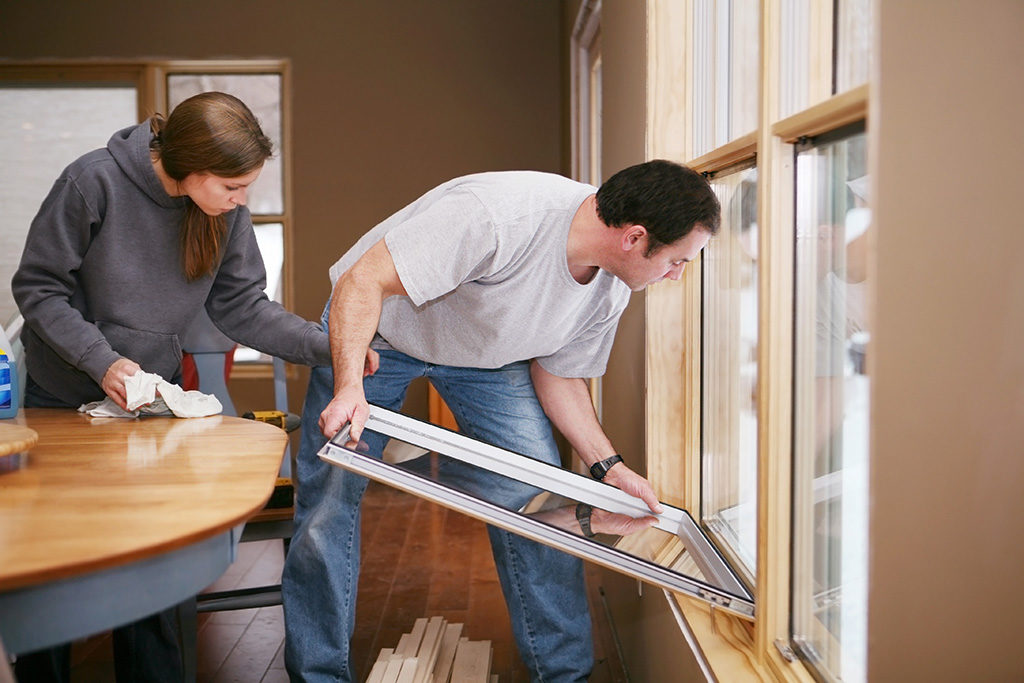
Getting Rid of Defects that Allow Air Seepage
Take a good look at the condition of your current windows. Are there signs that some of the sashes are a little warped? Perhaps those sashes are a little loose and there’s a fair amount of air seeping in around them. You may even notice that the sashes no longer close all the way. Those tiny gaps at the top or bottom allow even more air to enter the home.
Remember it’s not just about the sashes. If you look around the window frame on the inside and the outside, there may be tiny cracks. Along with bringing down the appearance of your home, those cracks also allow more air to seep into the place.
New windows eliminate these issues and seal those points of seepage. Without those cracks and other defects, your heating and air conditioning system will not have to run as often in order to maintain the desired temperature and humidity level in your home. Since the unit doesn’t run as much, it consumes less energy. Lower energy consumption translates into a lower energy bill each month.
Addressing the Window Type as a Way to Save on the Utility Bill
While new windows of any kind will reduce the amount of energy your HVAC unit consumes, some designs will be more effective than others. For example, have you considered moving from single pane windows to double panes?
As the name implies, double pane windows use a set of two panes rather than relying on a single pane of glass. There’s a small space in between the two panes. Many designs include a clear gas in that space that serves as an insulating material. The gas is completely clear and will not obscure the ability to see out the window at all. What it will do is work with the two glass panes to create a solid barrier for heat transference.
When the summer heat and humidity is high, double panes significantly reduce the amount of heat transference that occurs. This is true even if you don’t have trees or awnings that help to partially deflect the direct sunlight streaming through those windows.
A contractor can help you identify which kind of window design is right for each area of the home. That same contractor can point out how easy it would be to install double panes in any of those designs. Rest assured that the double panes will not detract from the curb appeal of your home. In fact, most people will not even notice the difference in terms of looks. Only you will know that the additional layering is one of the reasons why it’s so much easier to control the indoor temperature.
How Much of a Difference Will New Windows Make?
Several factors influence how much savings you will experience with the energy bills. The number and size of the new windows will have some impact. Where those windows are placed also make a difference.
For example, think about which of your outer walls receive the most direct sunlight and how many windows are part of the wall designs. More windows mean more opportunity to heat transference. By choosing to go with a pane type and a window design that provides more insulation for that wall, you reduce the rate of transference and save more money on utility costs.
While it’s difficult to come up with specific figures that apply to every window replacement project, it’s not unreasonable to expect a savings of anywhere between 25% and 52% on your monthly electricity bill. Assuming that your savings are on the low end, that could mean the $5,000.00 you normally spend each year on electricity would be reduced to $3,750.00. In five to seven years, those new windows could offset enough of the pre-replacement energy expense to pay for this part of your home improvement project.
There is no doubt that new windows will make a difference in the cost of heating and cooling your home. What remains to be determined is how much of a savings will occur. Contact a professional today and arrange for a full window inspection. Talk with the contractor about different window designs and which ones would offer the most in terms of reducing your energy costs. It won’t take long to identify a design that makes it easier to control the temperature inside, reduces your monthly utility bill, and improves the curb appeal of your house.
Looking For Ways To Reduce Your Summer Air Conditioning Bills? Start By Improving Your Attic
With summer around the corner, most homeowners are already wincing at the though of how much electricity they might have to consume cooling their home. The increase in sun’s intensity pushes the temperatures up forcing the HVAC system to work harder in order to keep the temperatures within an acceptable range.
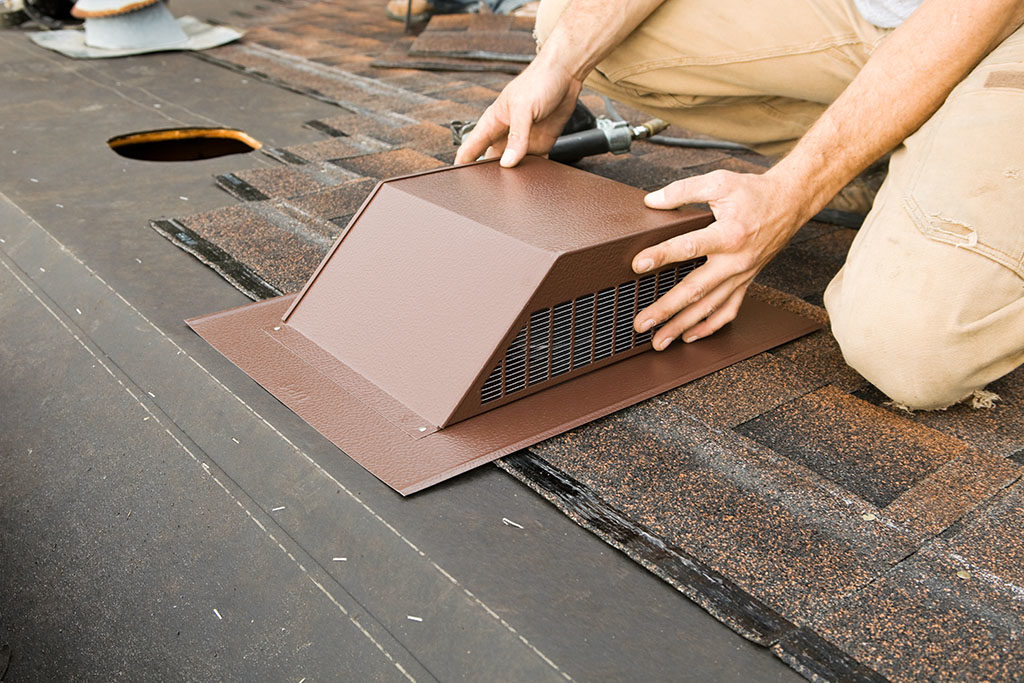
While most people will concentrate on better windows, a more efficient cooling system or a heat pump to cool home, very few think of how bad their attic is at keeping the house cool during the summer.
It is easy to ignore the attic especially if no one uses it regularly. The problem is that the better part of the heat comes into your house through the attic. The suns heats up the roof radiating energy into your attic and into the house. Dissipating this heat long before it gets into your home is a perfect way to reduce your summer air conditioning bills.
Very few attics can boast of basic amenities like sufficient windows and proper attic ventilation. This coupled with other features we are going to address here makes it very easy to use the attic to cool your house by keeping the heat away in the first place.
Think Attic Ventilation
Attic ventilation encourages air circulation hence cooling down the attic before it transfers that heat into your house. Since the attic will be too hot and perhaps not in active use, it would be counterproductive to introduce some AC vents there. After all, we are trying to cut down on costs not actively spend money to keep it cool.
Signs that You Need Improve Your Attic Ventilation
Most modern day homes are built with energy efficiency in mind. Consequently, constructors will install vents as a standard procedure. A quick inspection of your home is all you need to tell if you have the right attic ventilation
- Walk around the house inspecting your eaves and roof. If you don’t see any vents on the roof or the eaves, you have to add your own to improve ventilation
- Touch the ceiling on a warm day to find out how hot it is. A very hot ceiling tells you the attic is acting as a small solar oven and you have to improve it’s ventilation to keep the temperatures low
- Any ice forming on your eves during winter tells you that your attic is too warming meaning that it is poorly ventilated as it’s temperatures are very different from roof temperature hence it is melting the snow
- The rafters and roof sheathing will be moist in winter if air is escaping from your house into the attic. This means that you will need to revisit the insulation between the living space and the attic for better isolation
Natural Ventilation
Your first option would be natural ventilation. Introducing a couple of vents in the attic will encourage natural air floor. Once you have the vents in place, nature will take care of the rest. Hot air rises up. It will find its way up and out the house all creating a natural air current that draws in colder air from low placed vents and the rest of the house while expelling hot air from the top vents.
If your attic already has such vents, resist the urge to cover them up during the winter. Most homeowners think that covering the attic ventalation will keep the house warm and safer. While this might be true, a very warm attic in winter will encourage ice damming which could be dangerous to your roof.
Seal the Attic
If has unlimited access to your house, your ventilation will suck in cold air from the house up to the attic. While this might keep the attic cool, you will be wasting conditioned air on the attic and will still rise your HVAC bill.
Sealing the attic and minimizing air interaction between the attic and the house is a perfect way to minimize this. If you have low placed attic windows, prop them up to give alternative air intakes. Installing a few vents near the floor of the attic will create intake vents that will encourage the attic to set up its own natural air circulation without interfering with the microclimate your air conditioner works so hard to create in the rooms below.
Get a Reflective Roof
Attic ventilation might just do so much in helping keep your home cool during the summer. The other practical way to keep off most of the heat is keeping your roof as reflective as possible. Adding a sheet of reflective material below the roof and properly insulating your attic will increase its resistance to external heat.
If possible, invest on a highly reflective roof that bounces back most of the sun’s rays. Keeping your roof cool is the first step to keeping your attic cooler. If the attic doesn’t heat up, there won’t be the need to spend a fortune trying to cool it down in the first place.
Good ventilation will keep the attic cool. A cool attic will not slowly roast your living space forcing you to push your AC harder to keep a cool home. Improving air circulation is a perfect yet ignored way to bring your summer cooling costs low without investing in too much.
Help Your Air Conditioner Out This Summer By Improving Your Roof
Many homeowners and commercial property owners are interested in having less of an impact on the environment in Venice, Florida. They also like when their utility bills are lower because they are using green machines to operate their heating and cooling.

However, what many property owners do not realize is that their roof maybe the single biggest reason that air conditioning bills are high each year. Regardless, there are ways to create what is known in the industry as “cool roofs” that can bring down the overall temperature of your home or building. One of the advantages of amending the roof to be cooler is an overall lower air conditioning bill as well as extending the life of your current HVAC unit.
How cool roofs extend the life of your air conditioner
When your air conditioner has to work to capacity for long periods of the summer, it starts to take a toll on the machinery. Ultimately, the way you avoid replacing air conditioning as soon as the warranty expires is by not putting too much work on the machine in the first place. It also helps to regularly change the filter and have a scheduled maintenance appointment at least twice a year with an HVAC specialist. Basic maintenance aside, you do not need to lower the thermostat to uncomfortable levels in order to have an air conditioner that works past the warranty because you can lower the overall temperature of the building with a cool roof.
What is a cool roof?
You may have heard the term cool roof because it is a catchphrase that is being used by the federal government in America for reducing the country’s carbon footprint. The concept is fairly simple, and it is based on basic principles of science. In short, something that is white or a lighter color will reflect sunlight. An object that is a darker color, on the other hand, will absorb sunlight. In simple terms, when you have a blacktop parking lot, it can burn your feet if you are walking across it barefoot or in thin-soled shoes. Alternatively, concrete is usually lighter, and it does not absorb as much heat during extremely hot days. This simple concept is also active when it comes to your roof, and dark-colored shingles or tar on the roof can cause the overall temperature of your building to be higher. Although this could have some practical applications in areas of the country that have long winters with snow, areas of America like Florida that have long summers with extreme heat do not need a dark-colored roof.
Getting your tax deductions, rebates, incentives and grants
If you are already getting your roof color changed in order to bring down the overall temperature of your building, you could also be saving money in other ways with environmentally friendly improvements. For instance, there is a federal grant available that gives homeowners and property owners a tax rebate for installing insulation in the attic for the first time. Florida Green Building also has incentives for environmentally friendly home or commercial renovations that specifically address the Venice community.
Naturally, when you are having your roof color changed, you will have the opportunity to install insulation underneath it. The Department of Energy also has other helpful advice for homeowners and business owners that make environmentally friendly improvements to their property as well as a long list of tax rebates, grants and other programs. While the list is extensive, most of them mention that you will need to have a contractor perform the work in order to get your rebates or grants.
Learn more about the “heat island” effect
If you are interested in doing your part in creating a greener world, you will also hear more in the future about the heat island effect and the growing number of grants to combat it. Similar to the idea of changing a roof color in order to bring down the temperature of a home or building, the same scientific principle is applied to other large surfaces in cities. For example, blacktop absorbs more heat than concrete, and blacktop also stores the heat it absorbs during the day.
This means as the day progresses, the blacktop is still slowly releasing heat and it causes a city to be hotter for longer than the surrounding suburbs. As a property owner, you can significantly help the city save energy on cooling by doing your part to work against the heat island effect as often as possible. For instance, in addition to improvements on your own property, if there is an opportunity at your business to change the parking lot, you can suggest seeking out grants for replacing the blacktop with concrete or brick.
Gain LEED certification for your cool roof project
One of the biggest feathers in an environmentalist’s cap is LEED certification, and the scope of that process was expanded in 2016. For example, making changes to a property to combat the heat island effect by changing from blacktop to another material or building a cool roof can also help your company gain eligibility for LEED certification. According to the U.S. Green Building Council, the current LEED version four also includes homes as well as commercial or industrial properties.
Building An Addition Or Converting a Garage? Be Sure Your HVAC System Can Handle The Load
Have you considered adding onto your current home by expanding a garage into living space or building another room? Before you build, you need to ensure that your current HVAC system can handle the new load that increasing your square footage will bring. In addition to expanding the duct work and adding vents, an HVAC specialist can also help tailor your current air conditioner system. This way, you can ensure the HVAC unit does not break down unexpectedly because it cannot handle the increased workload.
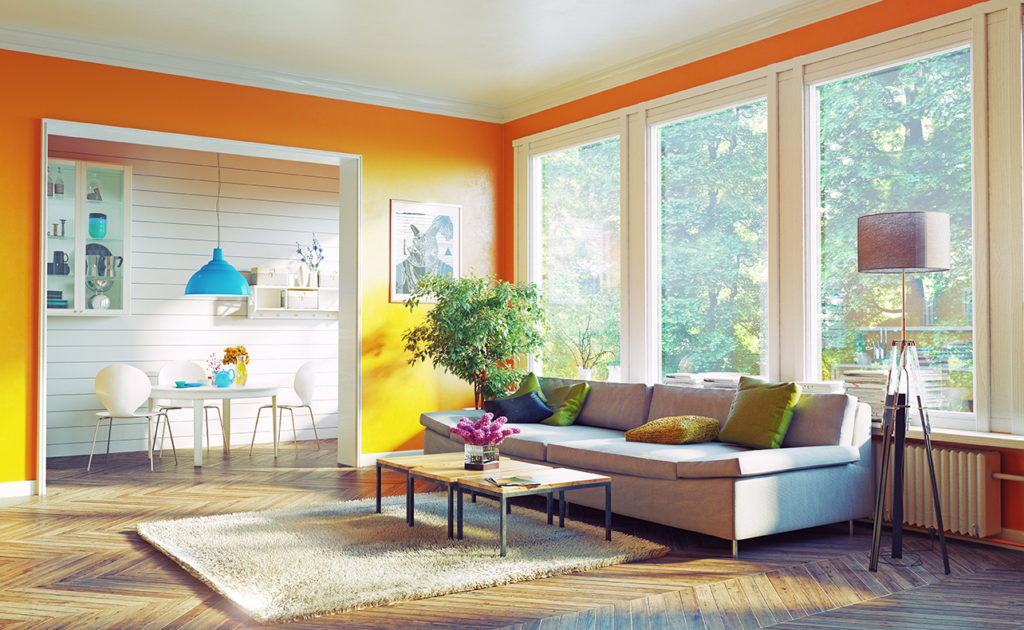
One major HVAC issue we see with additions that costs homeowners
Florida is a unique state because it is the home of many people that move here later in life from colder climates. When new residents buy properties in Florida, expanding the living space with a garage or addition might be done before they move in. Unfortunately, what new Florida property owners from colder climates might not know is that living in a subtropical climate means air conditioning is extremely important. Since so many homeowners are cranking their air conditioning at full-blast throughout most of the year, HVAC companies tightly regulate cooling in order to keep expenses as low as possible.
Why Florida HVAC systems tend to be maxed out
One of the ways Florida keeps their cooling bills low is by having pros tailor or re-engineer the HVAC machine to the specific square footage of the home or building it is cooling. This saves homeowners thousands of dollars per year, and it is highly recommended as being environmentally friendly. Unlike other parts of the country that have milder summers, a Florida HVAC unit can be compromised if the square footage of the home is expanded beyond the machine’s capacity.
How homeowners tax their HVAC unit during expansions
When the square footage of the home is increased, it is often done in ways that homeowners think are negligible. For example, adding one room might only be 250 square feet. Sadly, especially if an HVAC unit is aging, adding square footage that the machine was not expecting can cause it to work overtime. This means that homeowners will ultimately need to replace their air conditioning unit sooner than expected, and the warranty might not be honored. Fortunately, when an HVAC expert is hired to help with a home addition or expansion, the cooling unit can be amended to accommodate the increased workload.
Adding accessories like air handlers
One other way we help homeowners avoid a new air conditioner installation is by installing an air handler in the attic. This means that the air ducts at the highest point of the home are helped with a piece of equipment. This air handler will work to push more of the cooled air to the furthest areas of the home. This is especially important when the square footage of the home is increased during a renovation.
When HVAC units are no longer compatible
In some cases, it is not possible to amend the current air conditioning system to accommodate the increased square footage. In these particular cases, a new HVAC unit will be recommended that keeps a focus on your budget and square footage. Regardless of the cost, one of the main advantages of installing a brand new air conditioning unit is the spike in technological advances over the past five years. Driven by federal greener-planet initiatives, the Energy Star rated air conditioners will save homeowners in the short-term on their utility bills. In some cases, grants or tax rebates can be acquired that will reduce the cost of any Energy Star rated machinery you buy for your home. Assistance with the rebate or grant paperwork can be completed by a professional technician during installation of the HVAC system.
Using independent air conditioners versus HVAC units
When HVAC is not used to connect ducts and vents to a central system, independent units are used. In most people’s memory, this means an independent window unit, but these types of cooling systems are not compatible with luxury homes. In rare cases where duct work or vents are not appropriate, independent units will need to be installed that are not utilized with windows. These sophisticated air conditioners are similar to the kinds found in hotels, and can be mounted in ceilings, walls or on the floor.
Let us help you with your next remodel by sizing up your HVAC unit
Expanding the square footage of your home does not need to be a disaster that ultimately leads to your current AC system frying. To beat the heat while keeping your budget under control, let a certified HVAC technician help you with your home remodeling. We look forward to hearing from you in the Venice, Florida area, and we want to thank you in advance for choosing us to be part of your building team.
Improve Your Home With Landscaping And Help Keep Things Cooler Inside

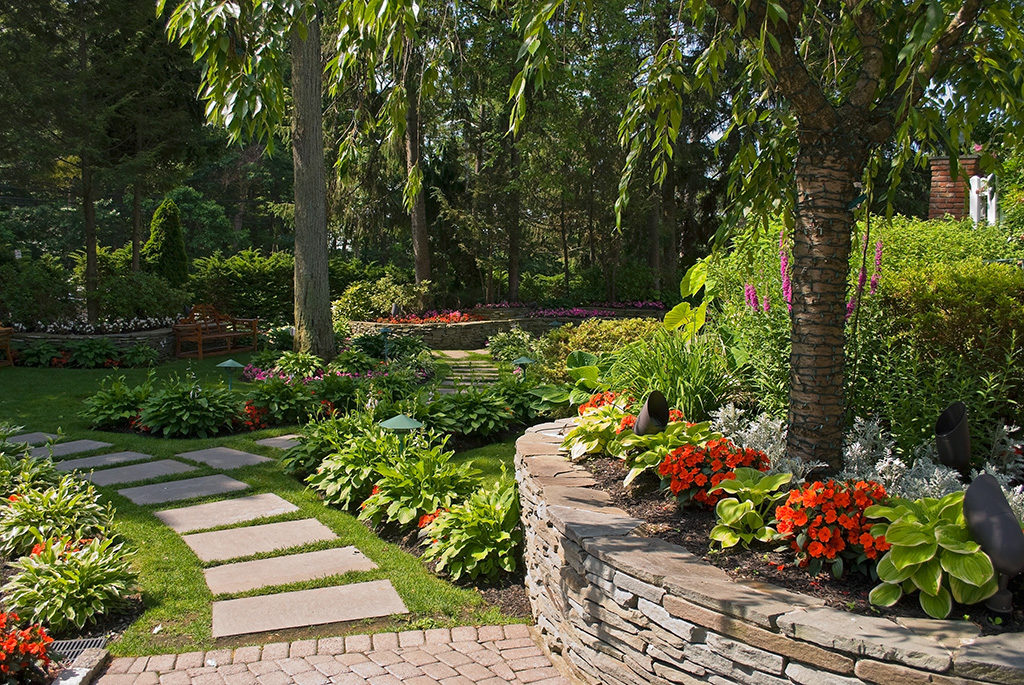
According to the U.S. Department of Energy (DOE), nearly half of all the energy you use in a typical year will go to just two actions: heating and cooling your home.
Right now, take a look at what you spent last year on energy. Now divide that amount in half. That is how much you can potentially save by reducing your indoor heating and cooling needs in other ways. And of course, every penny you save on air conditioning can go towards savings, college tuition for your kids, a great vacation or whatever you want to spend it on!
In this article, learn tips for investing in home improvement projects to beautify your lawn and garden can also shave valuable dollars and cents off your energy bills.
Tip 1: Trellis Vines.
According to the DOE, when solar energy gets absorbed through your windows and roofing, this will heat up your interior spaces just when you want them to be cool and comfy.
So how can you fix this common cause of increased cooling costs?
One of the best and fastest ways is to install a trellis structure and plant climbing vines. Unlike most people, most vines love heat and humidity, and they will grow fast and enthusiastically when given a structure to cling to. The key to success here is to select the right climbing vine for your USDA Plant Hardiness Zone.
For the best results, don't install the trellis right against the outer structure of your home, but a few feet away. This will allow air to circulate and prevent later issues with moisture or overgrowth that may affect your home's structural integrity.
Tip 2: Bushes and shrubs.
As the eco-friendly movement continues to gather steam, more homeowners are opting to save trees by planting bushes and shrubs that can serve as natural privacy "fences." Not only is this great for the planet, but it is also great for your cooling bill - if you plant the bushes and shrubs in the right places and choose the right plants for your Hardiness Zone (see Tip 1 here).
The first step here is to assess your home and identify areas where overheating occurs daily. Walls, windows and pavement can all act as heat conductors when exposed to hot, direct sunlight. Strategically planting shrubs or bushes effectively blocks that hot sunlight from radiating inwards into your home and also cools the surrounding air.
Plant bushes or shrubs close together so as they grow, they form a dense barrier against the heat. Leave a few feet between the greenery and your home's walls and foundation to avoid overgrowth, root barrier issues or moisture issues later on.
Tip 3: Trees.
There is no doubt that the canopy cover provided by trees can go a long way towards reducing your air conditioning expenses. But trees also come with their own maintenance needs, including pruning, raking, root barrier issues and other falling detritus such as seed pods, pine cones, acorns or faded flowers.
Here, it is vital to choose the trees you invest in with care. As the DOE points out, the right tree planted in the right place can lower your home's inside air temperature by six degrees naturally! That is a lot of energy saved!
The weather in your local geographic area should also influence what kind of trees you select. Deciduous trees, which lose their leaves in winter, will let the sunlight through in winter to lower your heating bills as well. This type of tree works best in more temperate climates where the winter weather is less extreme.
Evergreen trees, on the other hand, keep their leaves all year long and can provide a windbreak barrier against extreme weather conditions, which also lowers your heating costs by reducing the wind chill factor nearest your home's walls and foundation.
Tip 4 - Heights matter.
Finally, when choosing trees, shrubs, bushes and trellis vines, you should aim for a range of heights to gain protection from the sun at different times of day. With the right planting strategy, you can keep your home cooler naturally from morning all the way through until sunset each evening.
In winter, you can achieve the same level of home improvement by choosing the right type of greenery for your landscaping and planting it near enough to your home to provide protection but not so near it becomes its own winter weather risk.
According to the DOE's Energy Saver Infographic, if you plan out your landscaping with careful attention to enhancing shade and interior cooling, the investment can pay for itself in as little as eight years. After that, you will continue reaping the benefits of reduced energy bills and a cooler, more comfortable indoor space.
Improve Your Home By Reducing Dust With An Air Purifier
Hidden in the corner of a room might be a tall appliance that has a slight hum to its operations. These appliances are benign in the eyes of visitors, however, residents enjoy the rewards of clean air through these devices. In fact, air purifiers have been on the market for many years, and they come in countless shapes and sizes. If you've been thinking about purchasing an air purifier, consider how it improves your home by reducing a significant amount of dust. These particles affect your health each and every day.
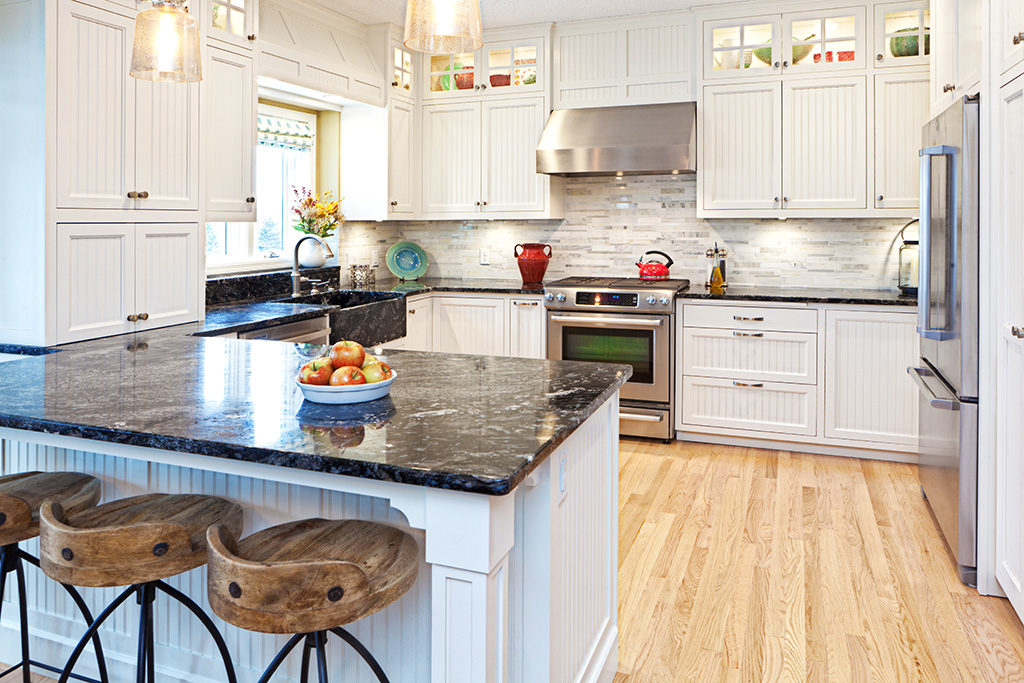
How Dust Enters the Home
In recent studies, researchers have found that most dust within the home actually originates from the exterior. Dust that flies in through screen doors and windows comes from soil, foliage and local industry particulates. All of these particles settle within the home, and you end up breathing most of them.
Dust is also created within the home from people and pets moving about on day-to-day chores. Pets leave dander, and people drop skin cells, for example. Most of these particulates remain in the air for a lengthy amount of time until they finally fall onto household surfaces. Unless you clean on a daily basis, this dust will remain in the home and circulate in the air for many days. As result, residents may have irritated respiratory systems and other health issues.
Dusty Harboring Areas
There's probably a lot more dust in your home than you realize right now. Did you know that ceiling fans can accumulate several centimeters of dust over a period of a few months? Any flat surface can become a harboring location for dust. If the wind or breeze picks up in the area, this dust becomes airborne and irritates your throat, nose and lungs.
Consider other dusty areas that might be a problem for sensitive residents. Shelves, lamp shades and even plant leaves can hold a lot of dust. Take a look at the vents that cover your central air ducts, for instance. Dust accumulates in these areas, and it becomes airborne as soon as you turn on the air conditioning or heating. Air purifiers are solutions to these inevitable dusty conditions that occur in every household across the nation.
Understanding Air Purifier Functions
Air purifiers have a simple design that makes them incredibly efficient in your household. When you plug in the unit, the purifier creates variable air pressure in front of it. Household air is literally drawn into the device and across its filters. The internal parts capture particulates that are incredibly small, but these same substances tend to be the most irritating to residents. The resulting air that exits the air purifier is as clean as possible. Your air purifier is as efficient as the complexity of its filters. Some devices filter large particles, whereas other models can filter incredibly tiny substances on a regular basis.
Replaceable or Reusable Filters
Currently, purifiers have distinct designs that include the interior components. You might rely on replaceable filters for the device, or you can try a model that has a reusable filter. These appliances are often more expensive, but they allow you to rinse and wipe the particulates off of the filter. Simply reinstall the filter when it's dry. When you're choosing between various purifiers on the market today, take a good look at the filter type. If you prefer to discard the filter rather than wash it, replaceable filters are your best choice.
Matching the Room Size to Purifiers
A standard purifier can only move a certain amount of air through its system at a given time. If your living room is relatively large, you may want to purchase an oversized device or possibly multiple models. In many cases, the purifier will have a volume specification listed on its retail packaging. Consider the size of your room along with the number of residents and pets in the immediate area. All of these factors contribute to dust and air volume within a given space. Ideally, you want the purifier to recycle the air within the room at least once an hour.
Maintenance Counts
Follow the directions for your air purifier after purchasing it. The filter must be cleaned or replaced on a regular basis or else the unit will fail to effectively clean the air. Ideally, check the filter once a week for any buildup. When you operate the unit on a regular basis, a monthly maintenance check should suffice.
Air purifiers are constantly being updated and revamped for consumers in the marketplace. When you're ready to purchase a new appliance, be sure to read reviews about your desired unit. Consider the energy usage, size and noise levels created by the purifiers. With a desired air purifier matched with your home, the entire household can benefit from clean air as pets, visitors and other loved ones move throughout the space.
A Dehumidifier Can Extend The Life Of Your Wood Flooring In Florida
Natural wood flooring is a feature that's still desirable to many homeowners despite lower-cost modern alternatives. Properly maintained hardwood floors can last for generations. However, they are sensitive to environmental conditions such as extreme temperatures and high humidity in climates like Florida. During the hot summer wood expands, but when the temperature drops in the winter, it contracts again. This is normal, but over time extreme contraction/expansion can lead to cracking or warping.
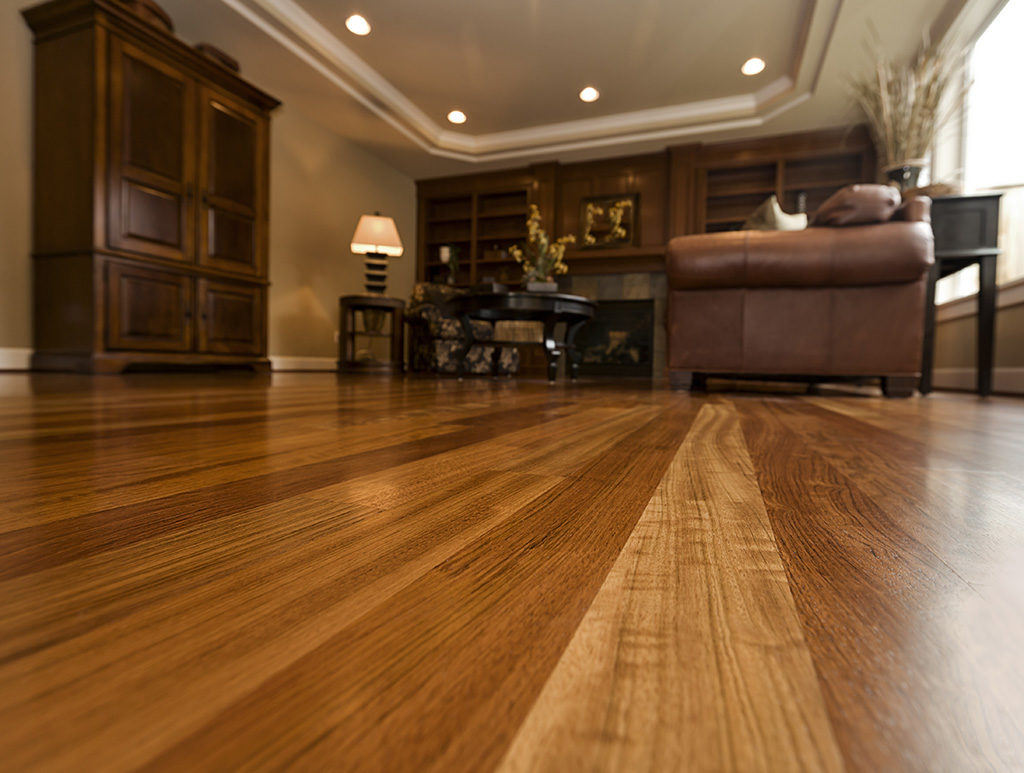
The best way to combat this is to maintain consistent levels of indoor humidity. As an absorbent material, wood will tend to reach equilibrium with the moisture levels of the surrounding air. Consistently high humidity can swell the wood by as much as 15 percent, though wood tends to swell much more cross-grain that it does along the grain While the optimal humidity for interior conditions can change for different types of wood, seasons, and climates, it's best to keep humidity somewhere in the 40 to 60 percent range to minimize contraction and expansion. This is similar to optimum comfort levels for people.
Winter Time
In the winter, while in general for Floridians the humidity usually does not get too high, it can at times be much dryer. Florida winters are prone to drought conditions and that can lead to much dryer air than we are used too. As such it's increasing humidity in the winter when the air is dry may be beneficial to keep wood floors from shrinking too much. Otherwise, the wood is losing moisture and can contract enough so that gaps appear between the sawn planks. This should not be a cause for alarm if the gaps are small and close up when spring comes.
In warm regions, like Florida, winter dryness is less of a concern. Winter time humidity levels in the Sunshine State tend to stay between 55 and 60 percent. As long as humidity doesn't fall below 40 percent, homeowners probably won't even see any gaps.
Summer Time
However, summer time is just the opposite. Humidity levels through the summer tend to vary between roughly 80 and 90 percent. In interior spaces with wood flooring, humidity should be maintained below 65 percent. Wood can tend to absorb a lot of that moisture, and after just a few days of excessive humidity, wood planks can begin to expand and warp.
This is especially evident in "cupping", where the edges of the planks expand against each other and tend to push upward, creating a convex surface down the middle of the plank. Even if the humidity is corrected, it can take some time for the wood to shrink back and regain it's flat contour.
Other Moisture Risks
Crowning: This is when it's the center of the plank that swells, producing the opposite effect of cupping. This can occur because of water soaking directly into the floorboards. It can also happen when cupping has left permanent ridges that are sanded off. When the wood compacts again, the middle of the board is higher than the edges.
Buckling: This happens when sections of the floor boards actually swell up and away from the subfloor, creating high and low spots. This is rare under normal conditions, but is likely to occur in homes that have experienced flooding, either due to weather or plumbing issues. Usually the only alternative is to replace the buckled planks.
Leaky roofs, bad plumbing, and even mild flooding in heavy rains can also damage wood floors. When that happens, fix the source of the leak, and mop or drain the water.
Use a dehumidifier and use a commercial drying fan in the affected area to remove excessive moisture. Also, keep in mind that damp wood is an invitation to mold, which can be toxic, and to termites, which can do extensive damage before you even know they're there.
AC and Dehumidifiers
Hot air can hold more moisture than cool air. When moist air encounters cold objects, that moisture tends to condense onto the cold surface as a result of natural equilibrium. That's how air conditioning helps to remove excess moisture from homes.
The warm, moist air from the interior deposits water droplets on the refrigerant-filled cooling coils. This water is allowed to drain away, thus continuously removing moisture from the home while the AC is running. A 12,000 Btu AC unit can remove three to four pints of water per hour. That sounds like quite a bit, but in high-moisture conditions, it may not be enough.
That's where dehumidifiers come in. An AC unit is designed primarily to cool air, and 80 percent of its energy use goes toward that end. Dehumidifiers, however, are designed expressly to remove moisture. They work in a similar manner, by pulling in air across cooling coils and collecting the moisture. The cooled air is then reheated and returned to the room for better redistribution.
Though the process seems much the same, dehumidifiers have much lower energy demands than AC units - about one-tenth. Many new models also come with humidistats so you can set the desired humidity levels. There are also whole-house dehumidifiers. Both whole-house and portable dehumidifiers will raise air temperature slightly, forcing the AC to work a little harder.
But in Florida, summer means long months of very high almost tropical humidity. Dehumidifiers used at night or in specific rooms can help to sharply reduce moisture levels.
Caring for Your Floors
Wooden floors, especially natural hardwood floors, can add to a home's value and visual appeal. They can be re-sanded and refinished whenever necessary. However, water damage is not so easy to fix and you should take special precautions to extend the life of your floors:
Do NOT clean wood floors with water, especially after sanding. Carefully sweep or vacuum them and use a new finish or cleaning product made for the purpose.
Do NOT let spilled water remain pooled on the floor. Wipe it up with rags or paper towels right away.
Run the AC and/or dehumidifier to maintain humidity levels.
Generally speaking, you want to use a dehumidifier during the drier winter months when humidity is high but interior temperature is not an issue. Run the AC in the summer, but be sure to have a means of measuring humidity to monitor for preferred levels.
Repainting your home can help keep things cooler inside
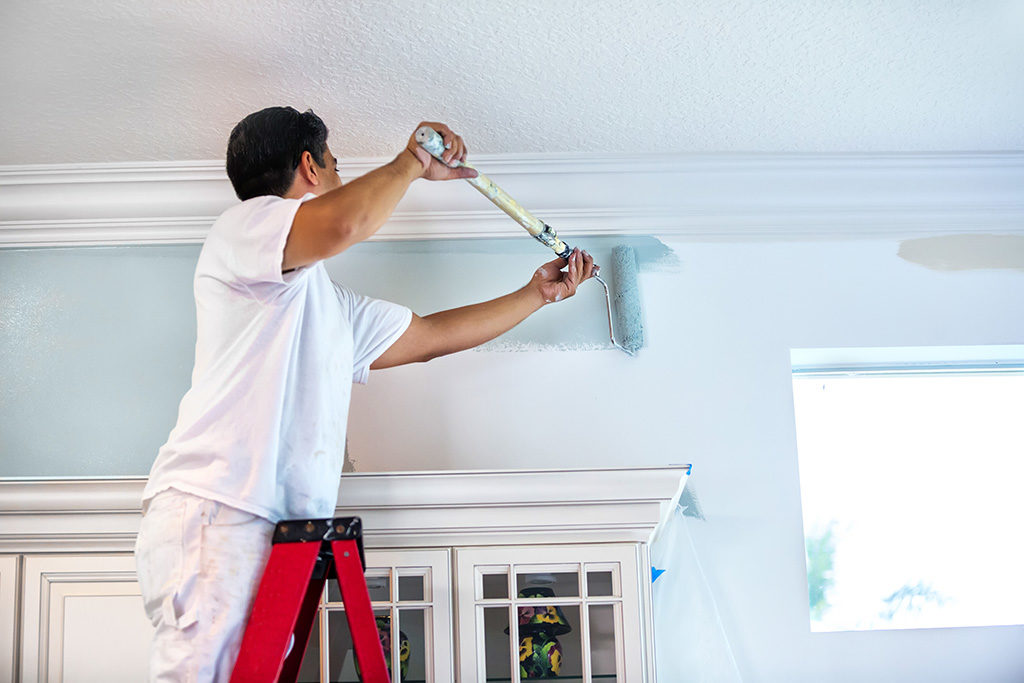
Beat the Heat
If you've lived in Florida long enough, you know that it can get pretty warm down here, especially in the summer. While you might have a tendency to crank up the air conditioner when things start to get warm, there's actually a more cost-effective and environmentally-friendly way to keep your home cool. All it takes is a little home improvement. By repainting your home in select "cooler" colors, you can enjoy a much more hospitable home environment. You just need to remember that cooler colors cool your home and reduce ac bills.
How Heat is Absorbed
You may have never considered the ramifications of having your home being painted a certain color, but it makes sense. After all, when it's hot outside, you most likely aren't wearing a black T-shirt, are you? If your home has a particularly dark color scheme, it's akin to your house wearing a giant black T-shirt. That said, the one who's going to end up sweating isn't your house, but rather, yourself. It's not a small amount either. A report from the Department of Energy found that 70 to 90 percent of the sun's energy can make its way into a home on the virtue of having a dark paint job. With lighter shades, that energy is reduced by around 35 percent. Your home could be over thirty percent color, and it wouldn't be at the expense of your energy bill.
Choosing the Right Colors
Therefore, if you are looking to repaint your home in hopes of cooling off, you need to shy away from colors that have a tendency to absorb heat. Lean towards lighter shades that are visually pleasing as well. Look through paint samplers and work to find a color which everyone can agree upon. If there are disagreements about the right color, then discuss amongst yourselves which colors you each would and wouldn't like to have for your house. Also, consider other actions you take to stay cool in the warmer months, such as wearing fewer layers and staying hydrated.
Getting Your Home Repainted
Repainting your entire home can be an arduous process, so it's best to leave it to professionals. When you contact a professional painting service, be sure to advise them of your intentions. They should be able to offer you additional guidance and possibly help steer you towards a shade of paint that you had not previously considered. Or, alternatively, they might steer you away from a shade that might not ward off rays quite like you were hoping it would. It is best to consider just how cool you would like for your home to be and the timing. You should also consider your plans for repainting now before it becomes too hot outside. You'll feel much better if you are pre-emptive when it comes to protecting your home against the heat.
Note the Differences
Having your home repainted is going to have a different cooling effect that having an air conditioner or even a heavy-duty fan running. You might not even be aware of how much cooler your home is until you step outside on a particularly muggy day or enter the home of someone whose paint scheme is much darker.
As good as staying cool feels for your personal body temperature, you're likely to feel a substantial amount of relief in your wallet. With less of a need to consume energy via your air conditioner, you should save substantially on energy. Compare your energy bills after having your home repainted with those from previous summers, and you should hopefully see a reduction.
However, there might be days which are particularly warm and your cool, new paint isn't quite enough to relieve you of the warmth. In these instances, it's perfectly understandable to use your air conditioning. However, since your home's heat is already reduced so much by the paint, you should feel comfortable with your air conditioning on a low setting.
Get Your Home Repainted Today
If you're dreading the upcoming summer and the high temperatures that will occur, fear not. You can reduce ac bills while still keeping your home as cool as possible. A cooler shade of paint for your house will cool you down much like shade under a tree. You just need to remember one thing: cooler colors cool your home.
Our Services
At Mahle Cool Air & Heating, we are dedicated to providing customers with the absolute best in home improvement for keeping your home as comfortable as possible. Whether it's a matter of helping to repair your air conditioner or offering thorough cleaning of your air ducts, we can ensure that you will be satisfied with the service you receive from us.
Window Treatments That Keep Your Home Cooler and Looking Great
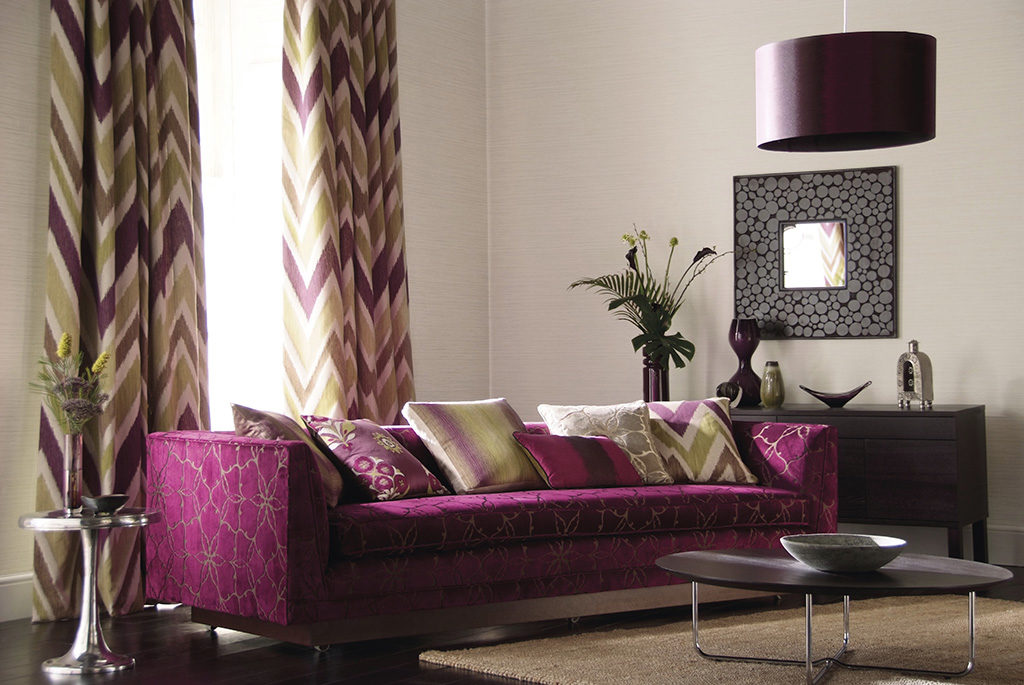
Home Improvement, Decorating, Energy Efficiency And Beautiful Windows
Residential Property Upgrades
Owning a home is always big responsibility. If you want to keep your residence running smoothly, you should make a point to explore any home improvement upgrade options that are available to you. Window treatments can impact your residence in a number of important ways, interestingly enough. They can reduce temperatures inside of your home, first and foremost. This can help you maintain a living space that's substantially cooler and more comfortable during the hottest times of the year. They can also decrease your monthly energy bills in a big way. If you're interested in maximum home comfort and in saving lots of money in general, it's the perfect time to research your choices in energy efficient windows.
Window Treatments and Your Home
Window treatments can add a lot to your property. They can make your property look more aesthetically appealing, for one. They make excellent decorations. They offer another key benefit, too. That benefit is energy conservation, a concept that's becoming increasingly important in this day and age. If you do your research and choose appropriate window treatments, you should be able to enjoy decreased heat loss during the colder winter months. You should be able to enjoy decreased summertime heat gathering as well. These advantages can be priceless for property owners who constantly worry about costly heating and cooling bills.
Selecting the Right Window Treatments
If you're serious about energy efficiency, you should carefully research all your choices in window treatments. Don't make any random purchases. Window blinds can be great for homes that wish to minimize heat collection in the summertime. They're not as effective, however, at minimizing heat loss during the wintertime. If your primary goal is to manage wintertime heat loss, you'll more than likely be better off going with another window treatment option. Window shutters can make a great option for property owners who wish to minimize wintertime heat loss. Exterior and interior window shutters alike can help in this department. The perks of windows shutters are abundant. They can help keep your windows safe and in tiptop condition. They don't require interior space. They offer extra security. They don't lead to the risk of thermal shock, either. It doesn't matter if you're interested in lessening heat loss or collection. Window shutters could be the perfect treatment option out there for you.
Other Popular Window Treatment Choices
There's no arguing the popularity of window blinds and window shutters. People everywhere are depending on these energy efficient window treatments for energy savings. You don't have to limit yourself to window blinds and window shutters for your home improvment requirements, however. That's because there are so many other effective and reliable window treatements out there waiting for you. If you want to investigate the vast universe of window treatements, you should look into storm panels. Interior and exterior storm panels can be excellent for people who wish to decrease heat loss in the wintertime. Interior panels can be particularly beneficial for windows that are equipped with awnings. If you're looking for maximum interior panel success, you should put them up prior to the colder months. You should take them off prior to the hotter months as well.
Shades are yet another beloved window treatment choice. If you install your shades the right way, you should be able to reap the benefits of considerable energy savings in your home. Dual shades can be especially effective. Look for dual shades that are a combination of light and dark. One side of the shade should be white. This will make it extremely reflective. The other side should be dark. Dark sides can soak up heat well. It's always smart to opt for shades that you can switch back and forth with brand new seasons.
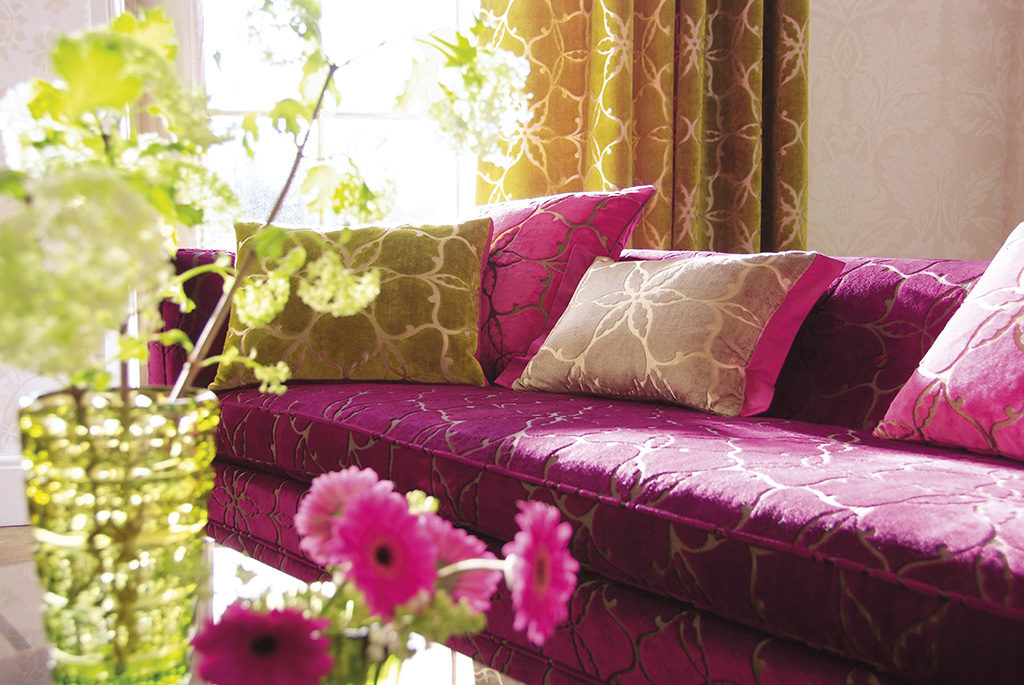
Take the Energy Efficient Path Today
Energy efficient window treatments can do wonders for your home. If you have a passion for home improvement, then you have no reason not to take the energy efficient route. Energy efficient windows can be great for your bank account. They can be great for your summertime and wintertime comfort levels as well. That's definitely not to say that they don't offer any other perks, either. Energy efficient windows can sometimes improve the insulation inside of your residential property. They can keep your belongings in good condition as well. That's simply because they can often defend your possessions from the aggressive effects of the sun's intense UV (ultraviolet) rays.
Contact Us As Soon As Possible
If you want to invest in window treatments that can enhance the appearance of your residence and keep it cool and comfortable at the same time, you should reach out to our trusted HVAC (Heating, Ventilation and Air Conditioning) company in beautiful Venice, Florida as soon as possible.
Landscape Your Air Conditioner?
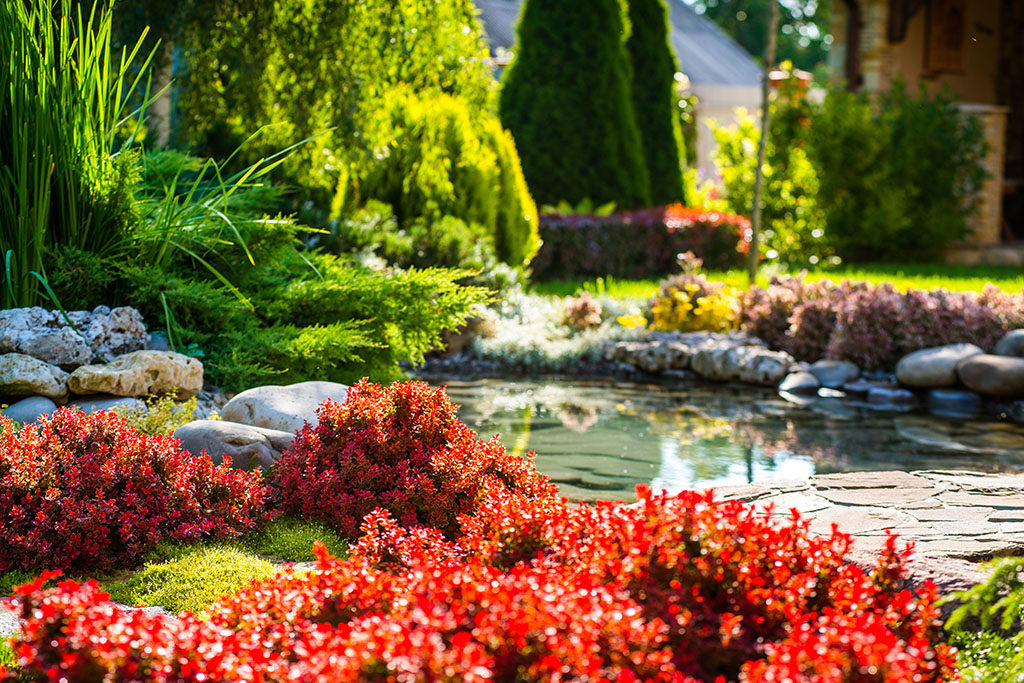
Landscaping Installation and Air Conditioning Units - Where Home Improvement and Lower AC Bills Meet
There are many ways to enhance your residential property, and if you're looking to better your home and strengthen your overall lifestyle at the same exact time, you may want to consider a little bit of landscaping work.
Landscaping installation, surprisingly enough, can be great for your outdoor air conditioning unit! Landscaping, first and foremost, can keep your air conditioner shaded, shielded from the elements and in tiptop condition. That protection, in turn, can boost your unit's efficiency. Remember your outdoor unit is made of steel and in many cases sits in direct sunlight all day. As the day goes on the energy from the can greatly heat the metal of your outdoor ac unit. If the outdoor unit gets very hot, it is harder for it to exchange heat and cool your home. Landscaping can do wonders for property owners who wish to shield their air conditioners from the sun's intense rays.
Landscaping installation can do more than just keep air conditioning units safe from the sun's effects. It can also offer aesthetic benefits. If you want to conceal your air conditioning unit effectively, landscaping can do the trick for you. Air conditioners make life more comfortable, cool and convenient. They're not the most attractive things on the planet, however.
There are quite a few exciting landscaping options available to property owners who want to keep their air conditioning units out of sight and out of mind. Hedges and plants can both work extremely well.
An efficient air conditioner can be a dream for anyone. If you want to reduce your monthly energy bills and save significant amounts of cash, you should do whatever you can to boost your unit's efficiency. You should make a point to put your air conditioner in a part of your outdoor space that receives ample shade. Doing so can reduce unit operation fees considerably. Consider planting on either the west or east parts of your property.
These locations get more sun than others. Trees and shrubs can keep your unit adequately protected in the warm summer months. Shade is beneficial because it has the ability to decrease temperatures. If you want to do whatever you can to stop your unit from overexerting itself, shade is your best bet.
It can be exciting to select plants for your outdoor property. Choices in plants run the gamut. If you want to maintain an air conditioning unit that's both reliable and efficient, you can explore a wealth of plants. If you want to reap the benefits of an air conditioner that's highly efficient and that can stay low-key visually, you should opt for plants that keep all their leaves in the wintertime if at all possible. Doing so can save you a lot of stress, hassle and energy. That's because it can eliminate the need for raking and cleaning duties. Fallen foliage tends to require substantial upkeep.
People frequently select hedges to put next to their air conditioning units. They offer versatility. If you want your hedges to look a certain way, trimming can be effective. You can make your hedges shorter if you so desire. You can make them emulate a certain form, too.
Lattice construction is yet another path you can consider. A metal or wood structure may be able to conceal your unit well. A lattice can also showcase gorgeous climbing plants that can take the attention away from your air conditioner. Lattice construction is easy and straightforward and therefore won't require much time and effort on your part.
Maintenance is important for most things in life. That's why upkeep should be a top priority for you. You should make a point to trim trees, shrubs, hedges and plants that are close to your air conditioning unit on a frequent basis. This is vital for encouraging both efficiency and airflow. If you want to keep your energy bills nice and low, you should never neglect anything that may be able to optimize efficiency. That can be a major mistake.
Cement can often be an issue for property owners who are looking for air conditioning efficiency. Cement is the polar opposite of shade in this scenario. It can actually boost temperatures by air conditioning units. If you have cement close to your unit, you should swap it out with plants that strike your fancy.
If you take the time to do your research, you should have great luck with landscaping installation and the defense and efficiency of your air conditioning unit. It doesn't matter if you go for plants, hedges, shrubs or even a lovely lattice, either. These choices can all work like a charm.
We're a prominent full-service HVAC (Heating, Ventilation and Air Conditioning) firm that's based in beautiful Venice, Florida. Suncoast residents who are searching for dependable professional assistance with home air conditioning units can always turn to our expertise. Our trained and NATE certified technicians specialize in all different types of air conditioning services including unit installation, replacement, maintenance and repair.
Our technicians are friendly and hard-working professionals who can talk to you about air conditioner efficiency as well. If you're in need of attentive, trustworthy and effective professional air conditioning service in Venice, Englewood, North Port or Sarasota, it's the perfect time to reach out to our company. Call us as soon as possible to request more information and to set up an appointment for our A+ work. We're a business that values exemplary customer care above all else.
